Being an Islamic country, Turkey’s rich history, boundless landscapes, and diverse cuisine invite visitors worldwide. Turkey’s cultural rug threads are woven with rich history and religious heritage. The blending of European and Islamic heritage serves as a bridge to combine East and West. The country has significant space in Islamic culture for hosting prominent historical events and is home to countless Muslim Sacred Places in Turkey. These sacred spaces are not just pilgrimage destinations but reflect the country’s architecture and old grandeur that still has magnificent value for visitors. They visit these places to enhance their spiritual experience and connect them with history, allowing worship and reflecting Ottoman architecture with full splendour. These Islamic spots play a vital role in shaping the local identity and have become a testament to evaluating the importance of spirituality in Turkish lives. Here is a list of Turkey's top 15 Muslim sacred places to add to your itinerary while planning the next trip.
1. Hagia Sophia, Istanbul
Originally, Hagia Sophia was built as a basilica to serve Christianity, but it faced several times with demolishing orders. It was the world’s largest cathedral, designed by Byzantine architecture. The Byzantines ruled this land for nearly 1000 years; later, in 1453, the cathedral was converted into a mosque when the Ottomans took over the charge. Hence, symbolically, the mosque symbolizes the triumph of Muslims over Christianity. The Ottomans made significant changes in building architecture, adding mihrabs and minarets. The mosque again faced its fall era in 1935 when the secular Republic defeated the Ottomans. The secularization period converted it into a museum, representing the old Christian and Islamic history. This transformation resulted in being listed in the UNESCO World Heritage. Again, in the 20th century, the Turkish government transformed it into a mosque.
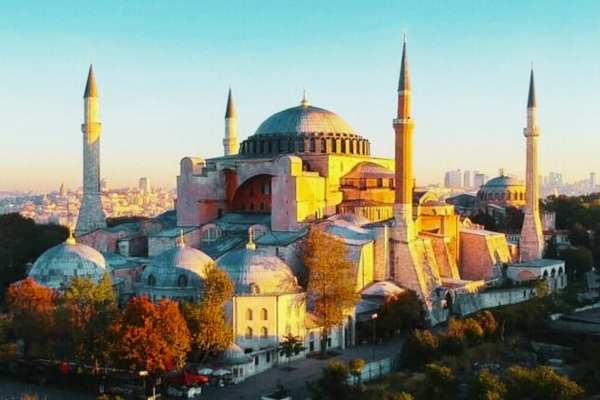 Hagia Sophia's fall and rise are symbolic and significant in reshaping Turkish history and culture. It has considerable significance in Muslims’ lives and is known as an architectural marvel. The floating dome at the central point of the mosque, its massive dome is a focal point for every visitor, looking like a float on the whole building's surface. High-quality materials, such as brick, marble, and granite, are used in this marvel construction, maintaining its endeavor regardless of the historical rise and fall.
Hagia Sophia's fall and rise are symbolic and significant in reshaping Turkish history and culture. It has considerable significance in Muslims’ lives and is known as an architectural marvel. The floating dome at the central point of the mosque, its massive dome is a focal point for every visitor, looking like a float on the whole building's surface. High-quality materials, such as brick, marble, and granite, are used in this marvel construction, maintaining its endeavor regardless of the historical rise and fall.
2. Blue Mosque (Sultan Ahmed Mosque), Istanbul
The name Blue Mosque symbolizes the blue tiles used in its construction. It was initially known as Sultan Ahmed Cami due to its location in the Sultan Ahmet district, which is famous in Turkey for having massive UNESCO World Heritage buildings. Around 20,000 blue tiles are used in the mosque's interior decoration, and glass windows reflect the sun's rays, allowing light to flood during the day. The mosque's architecture perfectly blends Ottoman and Byzantine styles, with six large minarets, one massive, and six small domes.
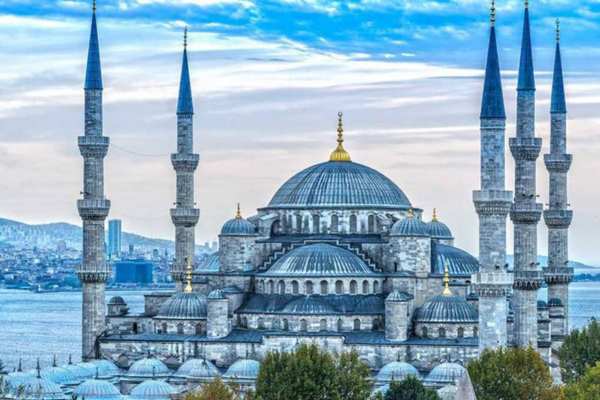 This mosque is significant in Turkey’s culture, representing the Ottoman Empire’s legacy and rulers’ architectural taste. Its construction with engineering technicalities and intricate design showcases the architectural expertise of that time. The floral pattern and calligraphy on the tiles enhance the mosque's beauty with motifs and roses on the surface. This colorful canvas draws artists and designers' attention worldwide to witness the historical art.
This mosque is significant in Turkey’s culture, representing the Ottoman Empire’s legacy and rulers’ architectural taste. Its construction with engineering technicalities and intricate design showcases the architectural expertise of that time. The floral pattern and calligraphy on the tiles enhance the mosque's beauty with motifs and roses on the surface. This colorful canvas draws artists and designers' attention worldwide to witness the historical art.
3. Süleymaniye Mosque, Istanbul
This mosque, located on the hilltop, is the largest establishing pilgrim site, designed by expert architect Mimar Sinan. The construction started after getting orders from Sultan Suleyman and completed the project in 7 years. According to all historical mosques, a hospital, madrasa, library, kitchen for the poor, shops, and hamam were built in the Suleymaniye complex. Some of these facilities are still in use by visitors. The upper golden dome dominates as a golden horn of the mosque, reflecting its legacy and importance in Turkish culture; noticeable constructions are Suleyman and his wife's tombs.
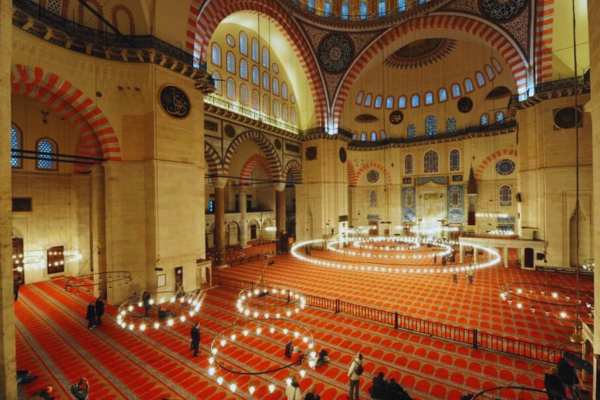 The ornamental work is less at this visiting complex; its simple but appealing architectural style matches visitors’ preferences. Four long and grandeur minarets are fixed in the corners of inner and outer courtyards, from which two are tall while the remaining two are of average height. The tall one has 3 stories whereas the shorter ones have 2 balconies. A portico with small domes and columns is developed in the inner courtyard, protecting visitors from rain and sun. A centered fountain in the entrance is used for ablution, and all inner areas are covered with carpets. The chandeliers have dim light, and candles must be lit at night, indicating the timing. Simple floral patterns, calligraphy, and geometrical shapes enhance inner beauty, and colorful design empowers its appealing look.
The ornamental work is less at this visiting complex; its simple but appealing architectural style matches visitors’ preferences. Four long and grandeur minarets are fixed in the corners of inner and outer courtyards, from which two are tall while the remaining two are of average height. The tall one has 3 stories whereas the shorter ones have 2 balconies. A portico with small domes and columns is developed in the inner courtyard, protecting visitors from rain and sun. A centered fountain in the entrance is used for ablution, and all inner areas are covered with carpets. The chandeliers have dim light, and candles must be lit at night, indicating the timing. Simple floral patterns, calligraphy, and geometrical shapes enhance inner beauty, and colorful design empowers its appealing look.
4. Mevlana Museum, Konya
This spiritual and cultural landmark is essential because it was a philosophy and teaching center. At the start, it was built as Rumi's mausoleum, built by a famous Persian poet of the 13th century. He was a beloved spiritual personality known worldwide for his teachings, transcending the religious, geographical, and cultural ideas of that time. Rumi's poetry's common themes were divine love, spirituality, and nature's truth. He developed a sense of an inner journey to get divine love; today, the Mevlana Museum has a tomb full of this great rumi.
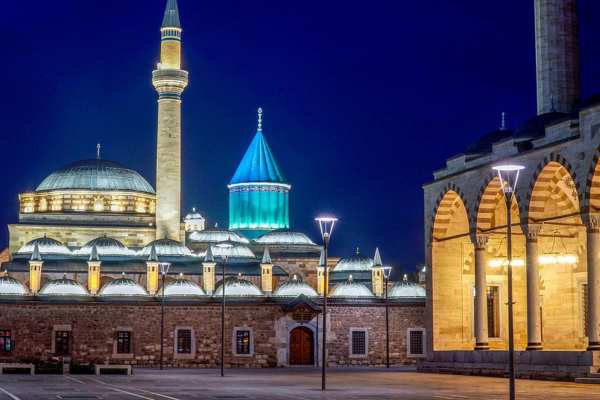 The tomb has spiritual importance due to Rumi's relevancy with it, who introduced a new world of Sufism through whirling dance, a type of soul meditation. Visitors come there for inspiration, spiritual renewal, and solace, as the museum teaches them a single lesson for not losing hope. This place is a pilgrimage site to bring hope and a beacon of light. The architectural beauty also presents a spiritual atmosphere with a majestic tomb, serene courtyard, and dervishes. People get a soothing and rejuvenating effect by visiting this Muslim Sacred Place in Turkey, as it has active worship and spiritual sites.
The tomb has spiritual importance due to Rumi's relevancy with it, who introduced a new world of Sufism through whirling dance, a type of soul meditation. Visitors come there for inspiration, spiritual renewal, and solace, as the museum teaches them a single lesson for not losing hope. This place is a pilgrimage site to bring hope and a beacon of light. The architectural beauty also presents a spiritual atmosphere with a majestic tomb, serene courtyard, and dervishes. People get a soothing and rejuvenating effect by visiting this Muslim Sacred Place in Turkey, as it has active worship and spiritual sites.
5. Selimiye Mosque, Edirne
This masterpiece was constructed by the same architect, Mimar Sinar, who designed Suleymaniye Mosque. The symbolic construction of the Ottoman Empire’s legacy and one of the most famous UNESCO sites has celebrated value in Islamic architecture. The architectural brilliance of this mosque lies in its massive central dome, strategically supported by four minarets. A vast open prayer hall and artistic work showcase its engineer's expertise in balancing modernity and sophistication. The central dome of this mosque is smaller than Hagia Sophia, yet it is noticeable to witness the innovative design of Sinan.
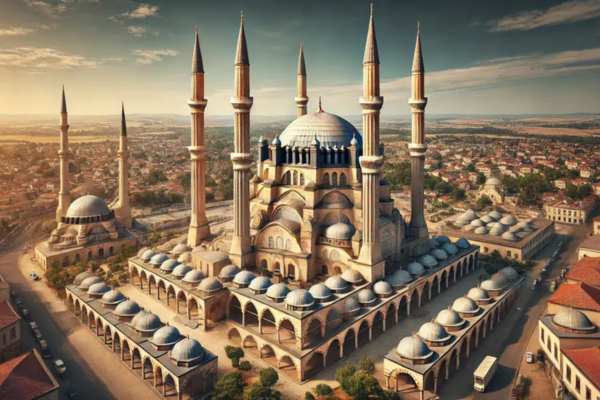 The interior work is completed with calligraphy, artwork, floral display, and geography patterns, enhancing its visual beauty and inviting visitors to experience its splendor. The mosque was built in Sultan Selim’s ruling period, after its name, Selimiye, and completed in 1574. Its grand structure and solid base symbolize the peak of the Ottoman period, and its central location in Edirne showcases the importance of this building. The city was the capital of the Ottoman Empire but later became a part of Istanbul. Currently, it serves as a worship place but allows visitors to experience the historical rise of Ottoman rulers.
The interior work is completed with calligraphy, artwork, floral display, and geography patterns, enhancing its visual beauty and inviting visitors to experience its splendor. The mosque was built in Sultan Selim’s ruling period, after its name, Selimiye, and completed in 1574. Its grand structure and solid base symbolize the peak of the Ottoman period, and its central location in Edirne showcases the importance of this building. The city was the capital of the Ottoman Empire but later became a part of Istanbul. Currently, it serves as a worship place but allows visitors to experience the historical rise of Ottoman rulers.
6. Eyüp Sultan Mosque, Istanbul
As expressed by name, the mosque has the tomb of Abu Ayyub Al-Ansari, who excitedly welcomed the last Prophet in Madina after Muslim migration. Ottoman rulers established the mosque after conquering Constantinople with the order of Sultan Mehmed II. The rulers discovered Abu Ayub al-Ansari’s tomb during their settlement in the city, and the mosque got its name to celebrate this event. Combining Byzantine and Ottoman architectural elements enhances its spiritual role; a vast courtyard invites visitors to perform religious activities.
This mosque is a worship place and a well-known pilgrimage site because it has the tomb of the famous companion of the last prophet, inviting Muslims around the world to seek divine blessings. Pilgrims believe that a holy visit to the tomb brings divine blessings and causes spiritual comfort. Famous Islamic events such as al-Miraj or Lailat al-Isra bring a crowd of pilgrims here to offer their prayers and seek meditation in the mosque. Pilgrims also visit this holy place in Ramadan to offer their Traweeh and break the fast.
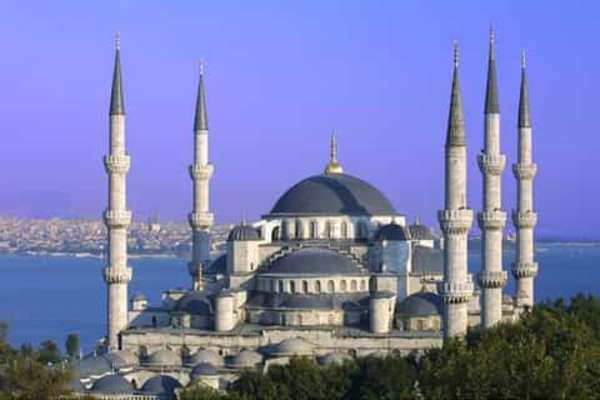
7. Yeni Mosque, Istanbul
The mosque's construction was started in 1597 upon the order of Sultan Safiye. Still, its completion took decades because the project was delayed due to the government’s political and financial challenges. After all the ups and downs, its inauguration was held in 1665 when Sultan Mehmed IV was the ruler. Soon after its opening, the mosque became a symbol of Ottoman power and urban development, vital to the city’s cultural heritage. Its proximity to the spice market makes it a focal point for all visitors in daily life. The architectural style of Yeni Mosque is Ottoman Baroque, which showcases the fusion of Western and Ottoman elements. The central domed hall is surrounded by small domes and semi-domes, symbolizing harmony in human life. The interior design has a blue and white combination decorated with Iznik tiles. Mehrab and Minbar have carved shapes with grand chandeliers hanging over them. The large windows on the sides allow natural light to come in. The large courtyard with a central fountain presents the Ottoman style.
8. Bursa Grand Mosque (Ulu Cami), Bursa
The mosque's construction started in 1396 when Sultan Bayezid I won the battle against Nicopolis and was completed in 1400. Its construction symbolizes the Ottoman Empire's growing and rapidly increasing influence. It also had importance as a first and significant worship place for the sultans of that time. The cultural impact and Ottoman architectural rise that started with this structure played an essential role in the Bursar's civic life. The construction has noticeable value in local life because Bursa was a significant trading center, and Ullu Cami was the focal point for developing cultural learning. The architectural style of Bursa Mosque presents a fusion of traditional Seljuk elements with Ottoman innovations. The large prayer hall has a giant central dome, supported by small domes and semi-domes, a famous old Seljuk style with the modesty of Ottoman emerging trends. Twenty central domes cover the entire hall and are a signature way to present a sense of openness and lightness in interior decoration. The stunning calligraphy, Quran verses, and decorative tile work make the interior most attractive and visually appealing. The wooden ceiling of the hall is painted, and the use of marble on the floors creates a magical combination.
9. Rüstem Pasha Mosque, Istanbul
The mosque was designed by Mimar Sinan, a famous and expert Muslim architect who designed most of Turkey's Islamic marvels. The place is renowned as a city pearl and is an attraction for its Iznik tiles, fixed in multiple floral, geometric patterns. These tiles were primarily applied to the mosque's mihrab, minbar, and facade. Up to 2300 tiles are arranged in 80 different patterns. The dome for this religious site was designed more than other mosques due to its construction in a massively built area.
The compact yet efficient design of the mosque indicates an intelligent use of small space, which the architect artistically utilized. The importance of this mosque can be concluded by the fact that a powerful Ottoman ruler, Rustem Pasha, commissioned it for construction. Visiting this mosque discloses a perfect combination of spirituality, functionality, and harmony. Using Iznik tiles and decorative elements indicates architects' craftsmanship, artistic techniques, and expert design.
10. Sabancı Merkez Mosque, Adana
The inauguration celebration of Sbanci Merkez Mosque was held in 1998, which allowed visitors to witness the combination of modernity and traditional Islamic architecture. The fundamental inspiration for its architectural style is the classic Ottoman, which was added minimally but cleanly to the design. Its central dome has support surrounded by six small domes. The interior design featured modern calligraphy and a touch of modernity, flexing the architect's unique approach. Using concrete and steel as modern materials and the spacious courtyard with historical artwork give the whole building a contemporary look. This is the first mosque to showcase innovation and traditional elements simultaneously. The mosque is crucial for its educational role in the Turkish community, hosting several educational activities to promote Islamic teachings. It is also a cultural center to host special events and manage gatherings for Ramadan and Eid celebrations.
11. Divriği Great Mosque and Hospital, Sivas
The construction of the mosque and hospital started in 1228 under the supervision of Ahlatshah, a famous architect of that time. This building was established as a multi-purpose space serving as a prayer mosque and a hospital to heal the community’s wounds. Combining a mosque and a hospital was so innovative at that time. The project showcases the intellectual and cultural achievements of the population by understanding their advanced needs. The hospital also served as a medical practice and education. Scholars and physicians utilized it as a research center to make various inventions. The hospital has an innovative setting with patient rooms, a lecture hall to educate new medical students and a spacious courtyard with a central fountain. The mosque has an enormous prayer hall with crafting glasswork and a beautifully designed interior. Symmetrical motifs, stone cravings, and functional layouts describe the cutting-edge expertise of that time's engineers. The architectural masterpiece was declared a UNESCO World Heritage Site due to its mind-blowing design and contribution to transforming Islamic art, medicine, and local culture.
12. Şakirin Mosque, Istanbul
The modern design of the mosque was influenced by traditional Islamic architecture and was designed by the first female architect in Turkey. Zeynep Fadıllıoğlu designed this mosque in a contemporary way that discloses the traditional elements with a modern touch. The central dome, minarets, and courtyards are built in the latest way with innovative materials. Large glass panels are installed on the side walls of the mosque, allowing natural light to enter the prayer hall and showing symbolic transparency. White marble is the main material of mihrab, whereas wood is applied in mimbar to collectively show contemporary and modern approaches. Like all other influential mosques of Turkey, Sakirin plays its functional role, allowing larger Muslims to offer their prayer, and its artistic design serves as a distinguished venue for cultural celebrations. Exhibitions and educational activities are also arranged at this venue to educate the community in an inclusive environment. The mosque has a separate prayer area for women, which is separated by a traditional glass partition and allows both genders to offer their prayers comfortably while maintaining masculine privacy.
13. Tomb of Joshua (Yuşa Tepesi), Istanbul
Joshua, a central figure of the Bible and Islam, was supposed to have been buried in Yuşa Tepesi of Istanbul. Still, the actual burial site was not confirmed, so a hilltop is believed to be the burial site of the mutual prophet. The site remained reverent for centuries; Ottomans regularly visited it to seek spirituality and faith symbols. Later, a small mosque was constructed on the tomb site to express its dignity. The tomb has noticeable value in Muslims' lives who visit it to seek blessings and offer their prayer in the side mosque. Turkey’s and local visitors show their respect for this tomb and visit it to enjoy the scenic beauty of the city from the hilltop. Bosphorus Strait’s entire view and reflective environment of surrounding areas have a soothing effect on visitors. The tomb site and chamber are well-maintained and cleaned by management to provide a retreating atmosphere for visitors to participate in prayers. They visit the place to admire the connection of history, natural beauty, and religious peace.
14. Hacı Bayram Mosque, Ankara
The mosque’s name is named after Hacı Bayram-ı Veli, who was a great Turkish scholar and poet. His influence on regional spirituality and transforming the local community’s thinking urged developers to retain the memories by placing a mosque's name after him. The mosque received several renovations since its building in the 15th century, but its grandeur and distinguished features are still important in Islamic heritage. The mosque's close association with Sufism and its religious functions makes it a central point for those seeking spiritual experience and following Sufi traditions. The tomb of Hacı Bayram-ı Veli is also developed in this mosque, and the attraction has been important for multiple generations. The central mosque and interior design attract the attention of visitors who want to experience the connection between Sufism and Byramani.
15. Bestepe Millet Camii, Ankara
The inauguration ceremony of this architectural marvel was held in 2017, reflecting the growing Turkish culture and religious significance of Islamic architecture. Its location near the president's complex showcases the country's developed stage and the trend of promoting Islamic heritage in spirituality and architecture. The visiting place has a spacious prayer hall decorated with high-quality and fine materials. Long, impressive chandeliers enhance its creativity, and the use of marble floors expresses the elements of modernity with old architectural traditions. Arched entries, calligraphy on walls, motifs, and floral patterns add creativity to the atmosphere. Final Analysis Turkey has countless religious places to visit, including pilgrim sites, architectural marvels, and regional heritage. A comprehensive visit to all the above-mentioned Muslim Sacred Places in Turkey will open a new world of history and knowledge. Whether you are a history buff, a lover of old architecture, or seeking spiritual peace, a visit to these religious places will give you a soothing effect and a memorable experience.





